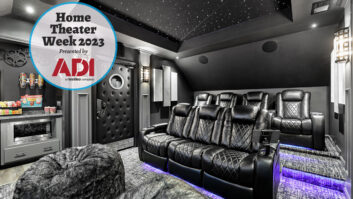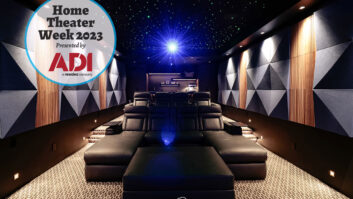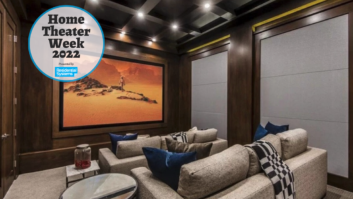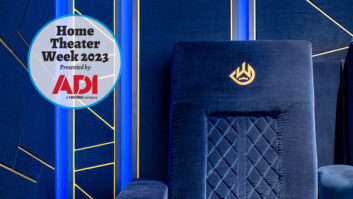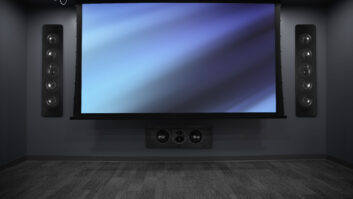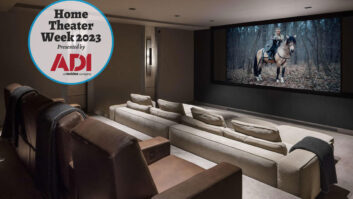In this final installment of the home theater calibration series, I will bring up a new and very fun topic: The End! We are almost done, out the door, adios, bye-bye, sayonara! After probably 10 hours of debugging, tweaking, dialing, measuring, tuning and recording data, we might actually be ready to pack up and get out of the customer’s house, but not so fast!
No good process works without the final step: Quality Control. You need to verify that all the phases in the lengthy calibration procedure were done properly and that all the data was collected and that the sonic results are as good as one would expect after spending so much time and energy.
Review Your Test Form
Because there are so many steps in calibrating a home theater audio system, it’s helpful to create a form to keep you on a “proceduralized” and organized track, and to record the data. Verify that you have actually made it through all the tests and adjustments indicated on your form. If you’re not sure what this form should include, I suggest that you look back at the main topics of the nine articles in this series and mark them all down in a document, making headings for each and every one and providing check boxes and note areas for collecting the data.
You might notice that you skipped a section because you had to take a call on your cell phone, or that you forgot to collect all the data on one test because you got distracted debugging a hum loop. If you don’t have all the data, it will be hard to write up a report of your work. It also may be hard to get the customer to pay for the calibration service. Every step should be completed, or marked as “Not Applicable.”
Listening Tests – Part 1: The Clinical Stuff
We’re going to listen to a few more test signals to check that everything is working correctly.
Verify Soundstage Construction: In theory, if all the speakers are well matched by their design, placement, room acoustic interaction and equalization, they will form stable and clear phantom images between pairs of them. The simplest way to check that out is to play steady bursts of mid-band pink noise signals in the speakers being tested and verify that the sound comes from a midpoint between the two speakers (forming a clear phantom image). A few test DVDs have such test signals, including the 5.1 Audio Toolkit DVD in Chapters 20 through 27 of Title 1. (So, okay, I produced the darn thing, and I like the way it works; can you blame me for recommending it?!) Listen first to the soundstage between the left and right speakers. The test signal should sound like it is suspended between the two speakers. If you’re not quite sure of the results, try moving your listening position to be exactly at equal distance from the two speakers. Also you can try inverting the polarity of the right speaker; you should hear a hole in the area between the two speakers, and the sound should appear to come from outside the pair width. If the image is not clear, you might need to verify the level settings, the distance/time delay settings, the equalization adjustments, and the speaker functionality.
Once you are satisfied that the left/right pair is working together properly, move on to the left/center pair. The next test signal on the 5.1 Toolkit DVD will take you there, and on other test DVDs you might have to hunt around for the corresponding test. Again, with this test you should hear the signal suspended between the left and center speakers. If you need better confirmation, try inverting the polarity of the center speaker and listen for the out-of-phase effect. If the results are not evident, you might need to perform all the checks I mentioned in the left/right pair testing.
Next, move on to the center/right pair, then the right/surround right pair, etc., all the way around the listening room in a clockwise direction. Again, the 5.1 Toolkit DVD is arranged for this sequence and, despite its name, will even work for 7.1 speaker Surround EX setups; other DVDs might need some navigation to get you around the whole room. One more set of tests would be to verify the images formed by any pair of speakers in the room. The 5.1 Toolkit DVD’s Chapters 27 or 28 send the pulsed pink noise signal to all the speakers. Shut off any of the speakers you don’t want to hear and listen for any chosen pair in the room.
Once you’ve assured yourself that the speakers are all able to create decent phantom images, you are most of the way there. Next comes the fun part.
Listening Tests – Part 2: The Music
Okay, enough of this test signal business; let’s hear some music. Start with some 2-channel material. Use program material you know very well from having heard it hundreds of times before. While sitting equidistant from the left/right speakers at or around the main seating area of the room, pay attention to the image projected by the two speakers. The phantom center sounds should be as sharp as if they were actually coming from the center speaker. Sounds produced to be spacious should be wide and open. The bass should be tight and not over-exaggerated like it is too often in multichannel systems with misaligned subwoofers. Bottom line, the 2-channel music should sound as good as it does on any high-end system you have ever experienced.
Next, move to multichannel music material. Now, finding material that’s really well produced can be somewhat of a challenge. Many recordings simply put instruments in the individual channels without much regard for a realistic soundstage. It’s a matter of taste, of course, but why can’t we get more of the fabulous soundscapes we have been experiencing from well produced 2-channel tracks? The musical cuts I selected for the Listening Tests in the 5.1 Audio Toolkit DVD all present a reasonably good soundstage, but one that is relatively sensitive to system alignment. If any of the levels are slightly off, if any of the speakers don’t match well, or if the time synchronization doesn’t match, the effect falls apart really soon on most of the cuts. These are tough cuts to play, and if they sound realistic, you know that the system is working well. Listen for the piano and cello presenting a good feel of a mid-size hall in Saint-Saens’ Carnival of the Animals in Chapter 2 of Title 3. Then listen for the sound swooshes during Back Seat by Venice Underground in Chapter 6 of Title 3.
Listening Tests – Part 3: The Movies
Now it’s time to check out how film soundtracks play over the system. First let’s understand what we are listening for, by considering the eight elements of quality that you need to be looking out for and grading for quality.
1) Clear dialog and articulation: Every line of dialog should come through clearly. Whether it be a BBC-grade super-enunciator or a muscular super hero with a thick Austrian accent and less than perfect diction, every line should be clear. Also, I find that this quality is parallel to articulation for musical instruments-the fact that you can hear the clicking keys on a clarinet, or that you can hear the scratching of fingers on the strings of an acoustic guitar tell you that the system is articulate and intelligible.
2) Precise sound localization: Some sounds in film tracks are designed to be heard at a precise location within the 360-degree soundfield. The sounds usually match a picture action and are most often in the frontal part of the room. So, how clear are these sounds in your system? Do they have a sharply focused location or do they float randomly in the soundstage? They should be as clearly located as if the real thing was there right in front of you.
3) Spacious surround effects: Some sounds in the film track are without precise direction and are made to envelop you the in sonic soundfield, thereby pulling you further into the action of the film. Most often, film sound designers use the surround channels to pump this enveloping field into the room, but there are plenty of examples of it being done with the front speakers, too. Can you actually get the sense of envelopment from the system and room, or are you constantly reminded that speakers are surrounding you? Ideally, you would forget all about the speakers and only hear and feel the enveloping soundfield.
4) Smooth sound movements: Sounds that move through space to punctuate a picture’s motion should sound like they are really in the film, and they should move effortlessly though the room. They should not jump from speaker to speaker, and they should not change in level as they go around the room. A great little effect to listen for is in Star Wars Episode 1: The Phantom Menace, Chapter 29. Right at the beginning of the chapter, a small yellow craft goes from front left to rear right in the picture and the sound is made to order. If all is right, the craft sounds like it is moving through the room with stunning conviction.
5) Even tonal balance: Harder to listen for because it takes some ear training and really good familiarity with the program material, this parameter refers to the frequency response of the overall system. There shouldn’t be any apparent emphasis of low, mid or high frequencies. All music, effects and dialog should sound realistic, given that the soundtrack was tastefully mixed. A good verification is against a pair of Etymotic ER4S earphones, which are truly reference grade transducers that you plug right into your ear canal. 6) Full dynamics: A film sound track can have a dynamic range in excess of 100dB. That’s because each channel is set up in the studio mixing stage to reach up to 105dB SPL, and the quietest sounds are down in the noise floor of the room. Your he-man surround system should play all of that without overloading or losing any of the low-level detail.
On the upper end of the dynamic range the limitations are power amplifier clipping and loudspeaker overload. If you have planned for plenty of reserve power and large enough speakers, then you should be okay. If you really want to know if you are clipping the amplifier, consider putting an oscilloscope on the output terminals of the amplifier and then observe the waveform on loud passages. The center speaker is usually the one with the highest sound levels, so check it first. A clipped waveform will look like flat lines at the top of the waveform, at a repeatable point in the waveform amplitude.
On the lower end of the dynamic range the main limitations will be room background noise and electronic hiss. Measure the room’s noise floor with a good real-time spectrum analyzer and listen to the background noise; it should be essentially inaudible. A good trick is to put earplugs in your ears and wait a few minutes. Pull out the earplugs and suddenly you will hear all the room noise that had until now gone unnoticed. For electronics hiss, listen in close to the speaker, then move back away from the speaker and notice if you still hear the hiss. If all is right, you shouldn’t hear any hiss at the listening location. If there is hiss, maybe a component has the wrong gain structure, or is simply inferior in quality. You can again try the earplug trick to help you notice the noise.
All of this should be audible on program material by the sense of dynamics you get in movies that go from very quiet to very loud. Movies by James Cameron tend to use this effect of sonic dynamics to punctuate action, so listen to his material.
7) Transparent system: Once you have listened for all the nit-picky stuff in items 1 through 6 above, sit back and enjoy the results. Do you notice after a few short moments that the system disappears from your attention? You shouldn’t hear the speakers. You shouldn’t hear the electronics. You should just hear the film soundtrack and be immersed in the film’s action, transported to another world.
8) Every seat a good seat: All of the above seven items should earn top marks at all the seats in the house, and that’s a pretty tricky thing. Getting really good sound at one optimized seat is tough enough, but getting it good everywhere is a very serious challenge. If you followed all the recommendations I’ve dished out over the nine-part series, and if the room is well designed, with the right speaker selection and good acoustics, you stand a good chance of having a broad sweet spot, with consistent tonal balance and sound staging throughout the seating area. Start listening at the “money seat” then move on to the other seats, while keeping your head at a constant height so that your acoustic memory can clearly hear the quality transitions.
Listen for these eight elements of sound quality and write down your reactions on your form. If anything doesn’t meet your performance expectations, take a closer look at the calibration parameters in your form and track down the source. Ultimately the system should sound fantastic.
The End
And now you’re done. You have preformed all the tests and adjustments required on your form, you have filled out all the boxes and collected all the data. If you used computer-controlled test equipment, such as the Gold Line DSP30, you have labeled all the files and are set to print them out in a final report to the client, and you are satisfied that the room actually sounds good on music and film.
The next step is to prepare a calibration report in which you summarize your actions and provide all the data, the adjustment parameters and settings of the equipment, and attach all the acoustic measurement data from your computerized system. This report package then goes out to the customer along with an invoice for the calibration service. The next step is to collect the check from your customer and to treat yourself to a nice dinner for a job well done.
Anthony Grimani is president of Performance Media Industries, an acoustical architecture firm specializing in home theater design and calibration ([email protected]).
